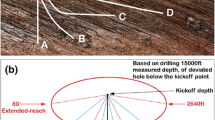Abstract
Formation water invasion is the most troublesome problem associated with air drilling. However, it is not economical to apply mist drilling when only a small amount of water flows into wellbore from formation during air drilling. Formation water could be circulated out of the wellbore through increasing the gas injection rate. In this paper, the Angel model was modified by introducing Nikurade friction factor for the flow in coarse open holes and translating formation water rate into equivalent penetration rate. Thus the distribution of annular pressure and the relationship between minimum air injection rate and formation water rate were obtained. Real data verification indicated that the modified model is more accurate than the Angel model and can provide useful information for air drilling.
Similar content being viewed by others
References
Angel R. R. (1957) Volume requirements for air or gas drilling.AIME, 210, 325–330
Cooper L. W. and Hook R. A. (1977) Air drilling techniques. SPE Deep Drilling and Production Symposium held in Amarillo, Texas, 17–19 April, 1977 (SPE paper 6435)
Cui Z. J. (1996) A new method for calculating air drilling parameters.Journal of Jianghan Petroleum Institute, 18(4), 64–68 (in Chinese)
Guo W. C. and Liu H. X. (2001) Calculation method of air drilling and its application software.Drilling & Production Technology, 24(1), 8–12 (in Chinese)
Li A. J. and Wang G. H. (1997) Modeling and research of gas, liquid and solid facies flow of air (atomized) drilling.West-China Exploration Engineering, 9(3), 5–10 (in Chinese)
Lyons W. C. (2000)Air and Gas Drilling Manual. Houston: McGraw-Hill Company. 161–169
Tian S. F. and Adewumi M. A. (1992) A new method of estimating mixture density in air drilling. SPE paper 24960
Zhou Y. C. (2003)Application of Underbalanced Drilling Technology. Beijing: Petroleum Industry Press. 180–183 (in Chinese)
Zhou Y. C., Gao D. L. and Liu Y. G. (2005) A new model for calculating bottom hole pressure of multiphase flow in annulus of underbalanced straight well.Acta Petrolei Sinica, 26(3), 96–99 (in Chinese)
Author information
Authors and Affiliations
Additional information
Wang Kexiong was born in 1965 and is studying for his PhD degree in the China University of Petroleum (Beijing). As an associate professor he is engaged in the research of oil/gas well engineering and geotechnical engineering. E-mail: wkx4328@sina.com
Rights and permissions
About this article
Cite this article
Kexiong, W., Laibin, Z. & Hongwei, J. Relationship between formation water rate, equivalent penetration rate and volume flow rate of air in air drilling. Pet. Sci. 4, 62–65 (2007). https://doi.org/10.1007/BF03187457
Received:
Issue Date:
DOI: https://doi.org/10.1007/BF03187457




